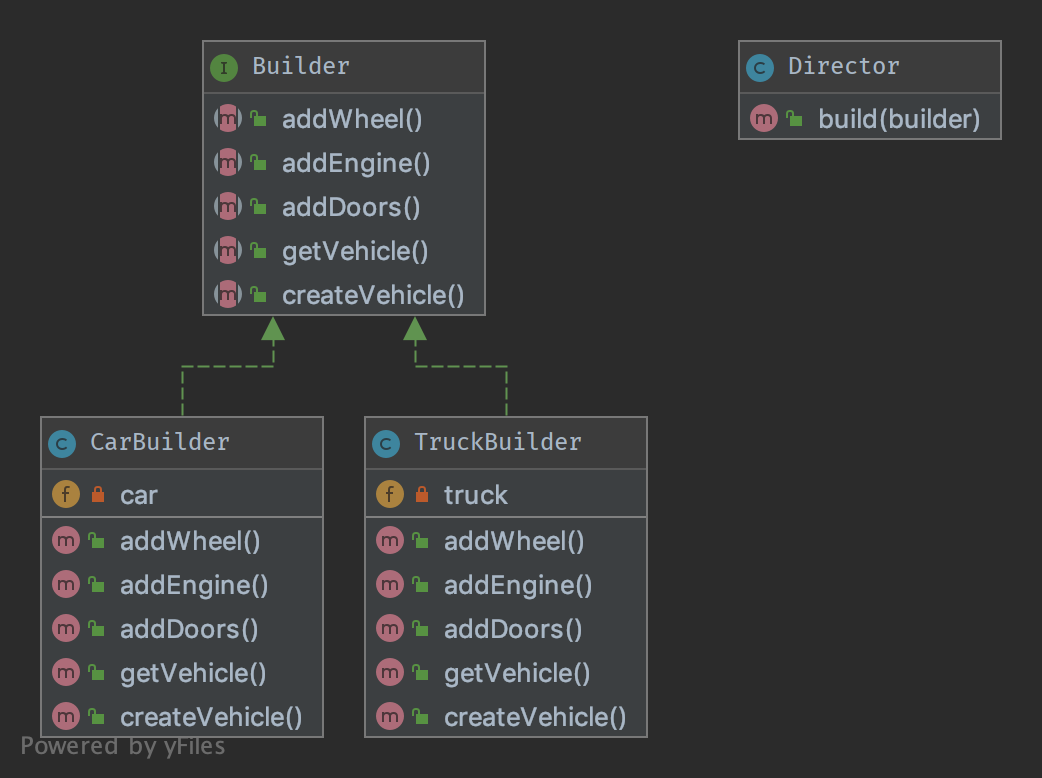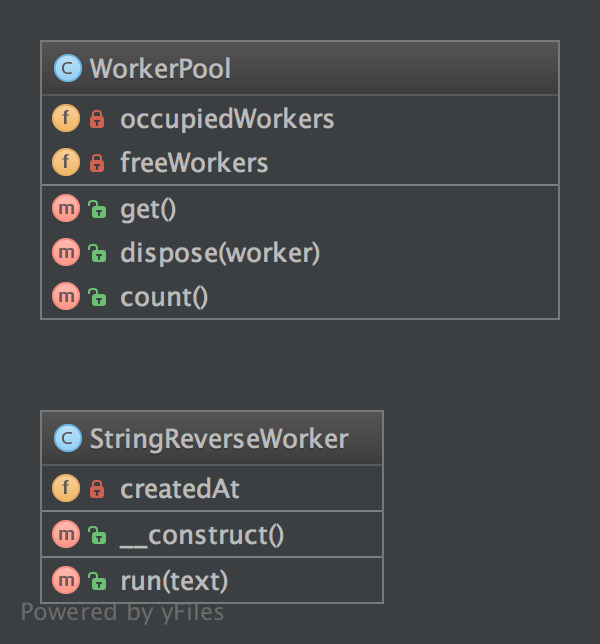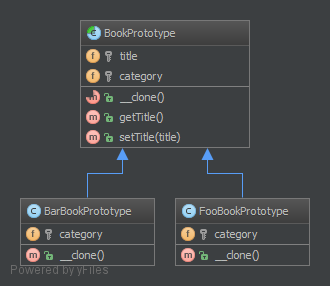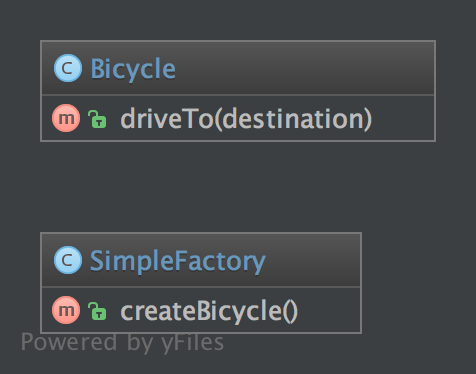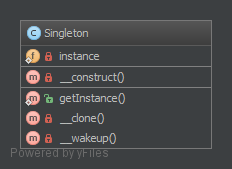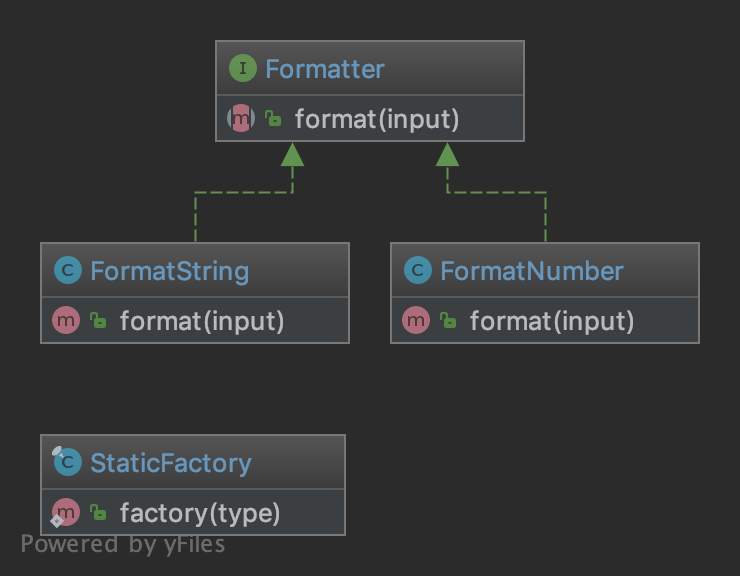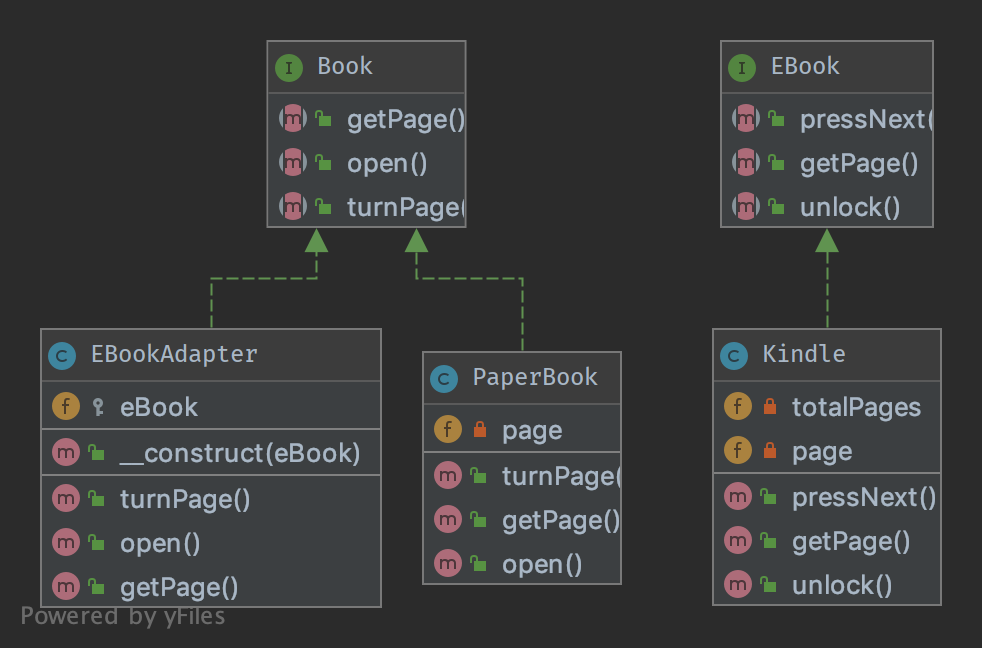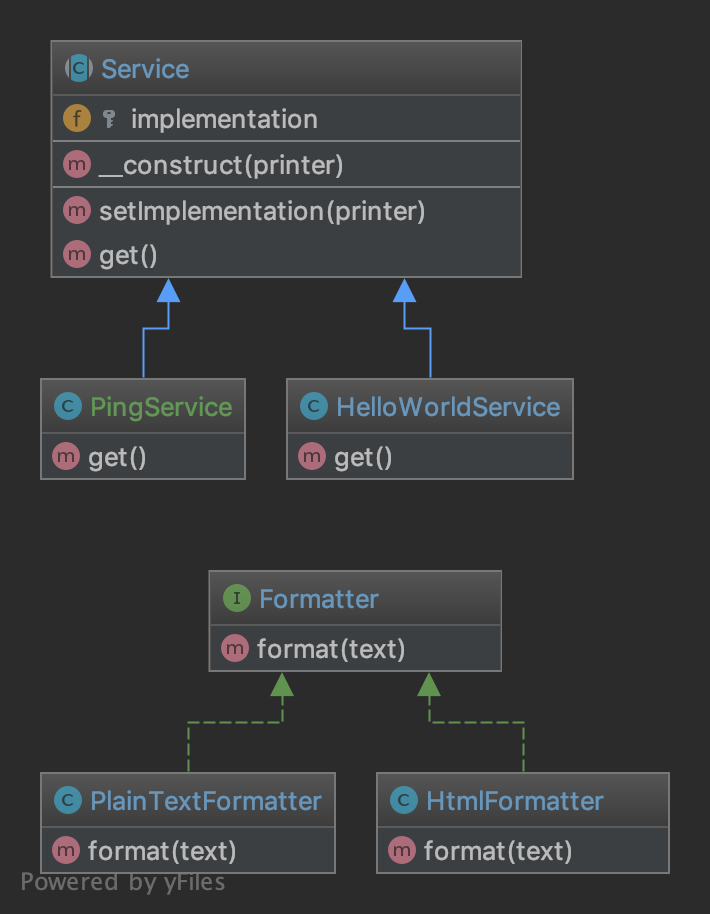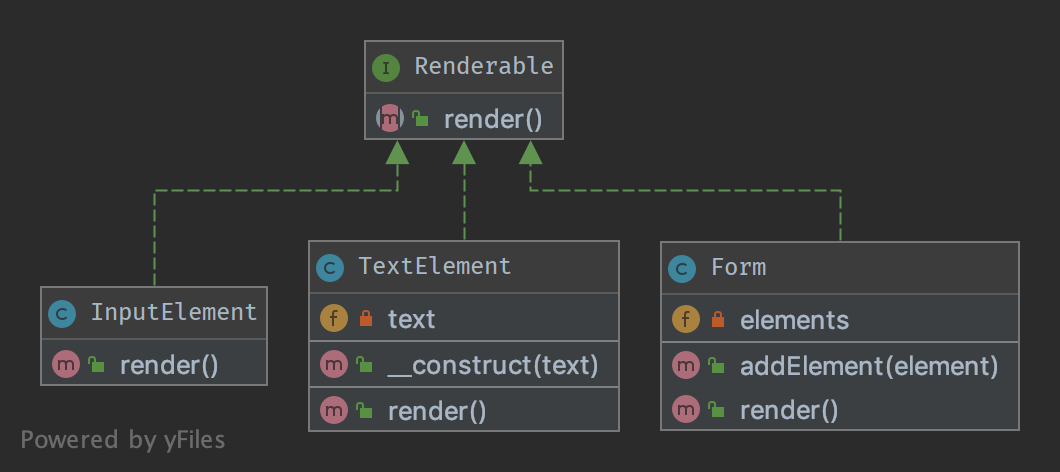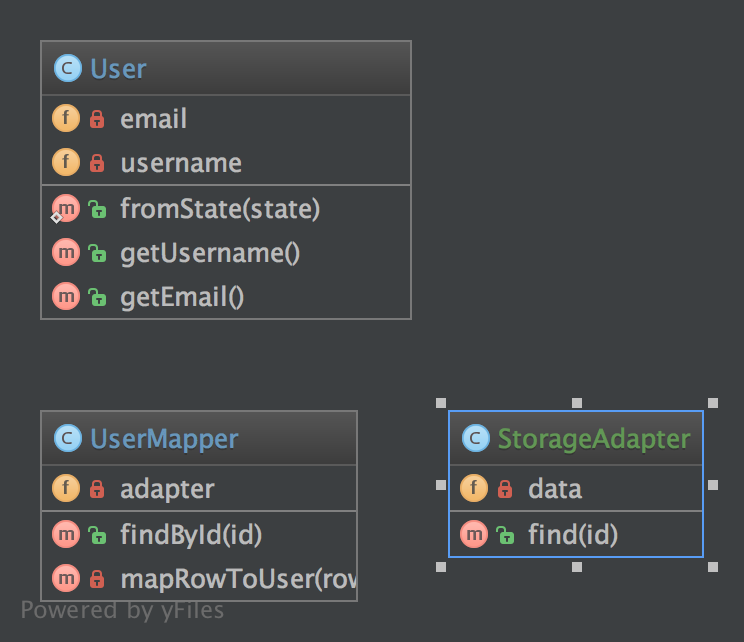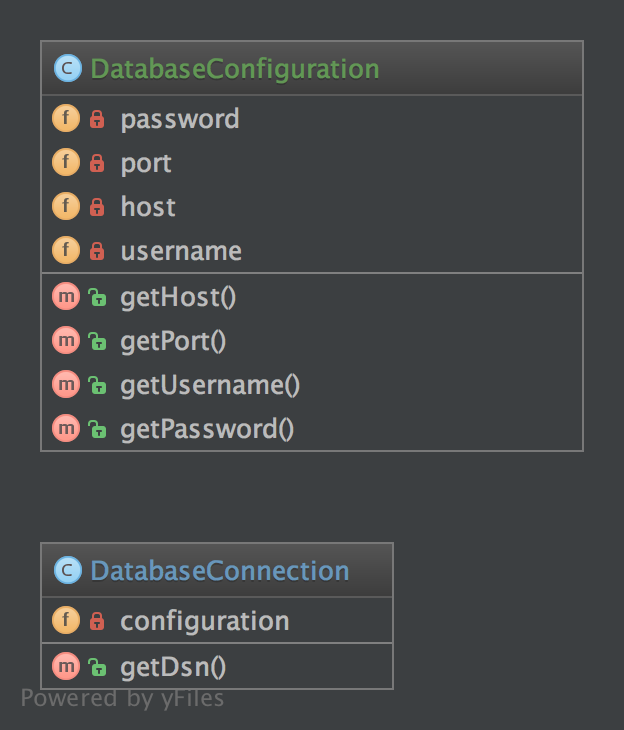一、创建型设计模式
1.1抽象工厂
1.1.1 目的
创建一系列互相关联或依赖的对象时,不指定他们具体的类。因为这些创建的类通常都实现了同一个接口。抽象工厂的客户端并不关心对象是如何创建的,而只知道它们是怎样组合的。
1.1.2 UML图
1.1.3 代码
在github上查看代码
WriterFactory.php
<?php
namespace DesignPatterns\Creational\AbstractFactory;
interface WriterFactory
{
public function createCsvWriter(): CsvWriter;
public function createJsonWriter(): JsonWriter;
}CsvWriter.php
<?php
namespace DesignPatterns\Creational\AbstractFactory;
interface CsvWriter
{
public function write(array $line): string;
}JsonWriter.php
<?php
namespace DesignPatterns\Creational\AbstractFactory;
interface JsonWriter
{
public function write(array $data, bool $formatted): string;
}UnixCsvWriter.php
<?php
namespace DesignPatterns\Creational\AbstractFactory;
class UnixCsvWriter implements CsvWriter
{
public function write(array $line): string
{
return join(',', $line) . "\n";
}
}UnixJsonWriter.php
<?php
namespace DesignPatterns\Creational\AbstractFactory;
class UnixJsonWriter implements JsonWriter
{
public function write(array $data, bool $formatted): string
{
$options = 0;
if ($formatted) {
$options = JSON_PRETTY_PRINT;
}
return json_encode($data, $options);
}
}UnixWriterFactory.php
<?php
namespace DesignPatterns\Creational\AbstractFactory;
class UnixWriterFactory implements WriterFactory
{
public function createCsvWriter(): CsvWriter
{
return new UnixCsvWriter();
}
public function createJsonWriter(): JsonWriter
{
return new UnixJsonWriter();
}
}WinCsvWriter.php
<?php
namespace DesignPatterns\Creational\AbstractFactory;
class WinCsvWriter implements CsvWriter
{
public function write(array $line): string
{
return join(',', $line) . "\r\n";
}
}WinJsonWriter.php
<?php
namespace DesignPatterns\Creational\AbstractFactory;
class WinJsonWriter implements JsonWriter
{
public function write(array $data, bool $formatted): string
{
return json_encode($data, JSON_PRETTY_PRINT);
}
}WinWriterFactory.php
<?php
namespace DesignPatterns\Creational\AbstractFactory;
class WinWriterFactory implements WriterFactory
{
public function createCsvWriter(): CsvWriter
{
return new WinCsvWriter();
}
public function createJsonWriter(): JsonWriter
{
return new WinJsonWriter();
}
}1.1.4 测试
Tests/AbstractFactoryTest.php
<?php
declare(strict_types=1);
namespace DesignPatterns\Creational\AbstractFactory\Tests;
use DesignPatterns\Creational\AbstractFactory\CsvWriter;
use DesignPatterns\Creational\AbstractFactory\JsonWriter;
use DesignPatterns\Creational\AbstractFactory\UnixWriterFactory;
use DesignPatterns\Creational\AbstractFactory\WinWriterFactory;
use DesignPatterns\Creational\AbstractFactory\WriterFactory;
use PHPUnit\Framework\TestCase;
class AbstractFactoryTest extends TestCase
{
public function provideFactory()
{
return [
[new UnixWriterFactory()],
[new WinWriterFactory()]
];
}
/**
* @dataProvider provideFactory
*/
public function testCanCreateCsvWriterOnUnix(WriterFactory $writerFactory)
{
$this->assertInstanceOf(JsonWriter::class, $writerFactory->createJsonWriter());
$this->assertInstanceOf(CsvWriter::class, $writerFactory->createCsvWriter());
}
}1.2 生成器模式
1.2.1 目的
生成器模式(Builder,或称建造者模式)是一个接口,用于构建复杂对象的各个部分。
在某些情况下,如果生成器对其构建的内容有很好的了解,那么这个接口可以是一个抽象类,并会有一个默认方法(也称适配器)。
如果对象具有复杂的继承结构,那么按照的正常逻辑,生成器也应该有一个复杂的继承结构。
注意:生成器通常有都有一个完善的接口,例如 PHPUnit 的模拟生成器(Mock Builder)。
1.2.2 例子
PHPUnit: 模拟生成器(Mock Builder)
1.2.3 UML图
1.2.4 代码
在 github 上找到这些代码
Director.php
<?php
declare(strict_types=1);
namespace DesignPatterns\Creational\Builder;
use DesignPatterns\Creational\Builder\Parts\Vehicle;
/**
* Director is part of the builder pattern. It knows the interface of the builder
* and builds a complex object with the help of the builder
*
* You can also inject many builders instead of one to build more complex objects
*/
class Director
{
public function build(Builder $builder): Vehicle
{
$builder->createVehicle();
$builder->addDoors();
$builder->addEngine();
$builder->addWheel();
return $builder->getVehicle();
}
}Builder.php
<?php
declare(strict_types=1);
namespace DesignPatterns\Creational\Builder;
use DesignPatterns\Creational\Builder\Parts\Vehicle;
interface Builder
{
public function createVehicle();
public function addWheel();
public function addEngine();
public function addDoors();
public function getVehicle(): Vehicle;
}TruckBuilder.php
<?php
declare(strict_types=1);
namespace DesignPatterns\Creational\Builder;
use DesignPatterns\Creational\Builder\Parts\Door;
use DesignPatterns\Creational\Builder\Parts\Engine;
use DesignPatterns\Creational\Builder\Parts\Wheel;
use DesignPatterns\Creational\Builder\Parts\Truck;
use DesignPatterns\Creational\Builder\Parts\Vehicle;
class TruckBuilder implements Builder
{
private Truck $truck;
public function addDoors()
{
$this->truck->setPart('rightDoor', new Door());
$this->truck->setPart('leftDoor', new Door());
}
public function addEngine()
{
$this->truck->setPart('truckEngine', new Engine());
}
public function addWheel()
{
$this->truck->setPart('wheel1', new Wheel());
$this->truck->setPart('wheel2', new Wheel());
$this->truck->setPart('wheel3', new Wheel());
$this->truck->setPart('wheel4', new Wheel());
$this->truck->setPart('wheel5', new Wheel());
$this->truck->setPart('wheel6', new Wheel());
}
public function createVehicle()
{
$this->truck = new Truck();
}
public function getVehicle(): Vehicle
{
return $this->truck;
}
}CarBuilder.php
<?php
declare(strict_types=1);
namespace DesignPatterns\Creational\Builder;
use DesignPatterns\Creational\Builder\Parts\Door;
use DesignPatterns\Creational\Builder\Parts\Engine;
use DesignPatterns\Creational\Builder\Parts\Wheel;
use DesignPatterns\Creational\Builder\Parts\Car;
use DesignPatterns\Creational\Builder\Parts\Vehicle;
class CarBuilder implements Builder
{
private Car $car;
public function addDoors()
{
$this->car->setPart('rightDoor', new Door());
$this->car->setPart('leftDoor', new Door());
$this->car->setPart('trunkLid', new Door());
}
public function addEngine()
{
$this->car->setPart('engine', new Engine());
}
public function addWheel()
{
$this->car->setPart('wheelLF', new Wheel());
$this->car->setPart('wheelRF', new Wheel());
$this->car->setPart('wheelLR', new Wheel());
$this->car->setPart('wheelRR', new Wheel());
}
public function createVehicle()
{
$this->car = new Car();
}
public function getVehicle(): Vehicle
{
return $this->car;
}
}Parts/Vehicle.php
<?php
declare(strict_types=1);
namespace DesignPatterns\Creational\Builder\Parts;
abstract class Vehicle
{
public function setPart(string $key, object $value)
{
}
}Parts/Truck.php
<?php
declare(strict_types=1);
namespace DesignPatterns\Creational\Builder\Parts;
class Truck extends Vehicle
{
}Parts/Car.php
<?php
declare(strict_types=1);
namespace DesignPatterns\Creational\Builder\Parts;
class Car extends Vehicle
{
}Parts/Engine.php
<?php
declare(strict_types=1);
namespace DesignPatterns\Creational\Builder\Parts;
class Engine
{
}Parts/Wheel.php
<?php
declare(strict_types=1);
namespace DesignPatterns\Creational\Builder\Parts;
class Wheel
{
}Parts/Door.php
<?php
declare(strict_types=1);
namespace DesignPatterns\Creational\Builder\Parts;
class Door
{
}1.2.5 测试
Tests/DirectorTest.php
<?php
declare(strict_types=1);
namespace DesignPatterns\Creational\Builder\Tests;
use DesignPatterns\Creational\Builder\Parts\Car;
use DesignPatterns\Creational\Builder\Parts\Truck;
use DesignPatterns\Creational\Builder\TruckBuilder;
use DesignPatterns\Creational\Builder\CarBuilder;
use DesignPatterns\Creational\Builder\Director;
use PHPUnit\Framework\TestCase;
class DirectorTest extends TestCase
{
public function testCanBuildTruck()
{
$truckBuilder = new TruckBuilder();
$newVehicle = (new Director())->build($truckBuilder);
$this->assertInstanceOf(Truck::class, $newVehicle);
}
public function testCanBuildCar()
{
$carBuilder = new CarBuilder();
$newVehicle = (new Director())->build($carBuilder);
$this->assertInstanceOf(Car::class, $newVehicle);
}
}1.3 工厂方法
1.3.1 目的
相比 简单工厂模式(SimpleFactory)而言,工厂方法模式(Factory Method)可以通过延伸出子类,实现用不同的方法创建对象。
对于比较简单的情况,这个抽象类可能只是一个接口。
这是一个 “真正” 的设计模式,因为它遵循了”依赖反转原则(Dependency Inversion Principle)” 。也就是 SOLID 原则中的”D”。
这意味着工厂方法实现的类依赖于类的抽象,而不是具体的类。这也是 工厂方法模式 与 简单工厂模式 和 静态工厂模式 之间最重要的区别。
1.3.2 UML图
1.3.3 代码
在github上找到这些代码
Logger.php
<?php
declare(strict_types=1);
namespace DesignPatterns\Creational\FactoryMethod;
interface Logger
{
public function log(string $message);
}StdoutLogger.php
<?php
declare(strict_types=1);
namespace DesignPatterns\Creational\FactoryMethod;
class StdoutLogger implements Logger
{
public function log(string $message)
{
echo $message;
}
}FileLogger.php
<?php
declare(strict_types=1);
namespace DesignPatterns\Creational\FactoryMethod;
class FileLogger implements Logger
{
public function __construct(private string $filePath)
{
}
public function log(string $message)
{
file_put_contents($this->filePath, $message . PHP_EOL, FILE_APPEND);
}
}LoggerFactory.php
<?php
declare(strict_types=1);
namespace DesignPatterns\Creational\FactoryMethod;
interface LoggerFactory
{
public function createLogger(): Logger;
}StdoutLoggerFactory.php
<?php
declare(strict_types=1);
namespace DesignPatterns\Creational\FactoryMethod;
class StdoutLoggerFactory implements LoggerFactory
{
public function createLogger(): Logger
{
return new StdoutLogger();
}
}FileLoggerFactory.php
<?php
declare(strict_types=1);
namespace DesignPatterns\Creational\FactoryMethod;
class FileLoggerFactory implements LoggerFactory
{
public function __construct(private string $filePath)
{
}
public function createLogger(): Logger
{
return new FileLogger($this->filePath);
}
}1.3.4 测试
Tests/FactoryMethodTest.php
<?php
declare(strict_types=1);
namespace DesignPatterns\Creational\FactoryMethod\Tests;
use DesignPatterns\Creational\FactoryMethod\FileLogger;
use DesignPatterns\Creational\FactoryMethod\FileLoggerFactory;
use DesignPatterns\Creational\FactoryMethod\StdoutLogger;
use DesignPatterns\Creational\FactoryMethod\StdoutLoggerFactory;
use PHPUnit\Framework\TestCase;
class FactoryMethodTest extends TestCase
{
public function testCanCreateStdoutLogging()
{
$loggerFactory = new StdoutLoggerFactory();
$logger = $loggerFactory->createLogger();
$this->assertInstanceOf(StdoutLogger::class, $logger);
}
public function testCanCreateFileLogging()
{
$loggerFactory = new FileLoggerFactory(sys_get_temp_dir());
$logger = $loggerFactory->createLogger();
$this->assertInstanceOf(FileLogger::class, $logger);
}
}1.4 对象池
1.4.1 Purpose
对象池设计模式是一种创建型设计模式。它使用一组提前已准备完成可以使用的对象,而不是根据需要分配或销毁。这种来源被称为:“池”(pool)。池的使用者将从池中请求一个对象,并对返回的对象进行操作。在客户端处理完成后,它将返回一种特定类型的工厂对象。返回给池,而不是销毁。
对象池模式在一些情景下可以带来明显的性能提升。如:类实例初始化成本较高、类的实例化率较高、或类实例同时使用率不高的情况下。当创建新对象(尤其是通过网络)的时间花费不确定时,池对象的获得时间却是可预测的。
这些优点对于时间要求敏感的对象来说,是非常有用的。例如:数据库连接、套接字连接、线程和大型图形对象(如字体或位图)。但在某些情况下,简单的对象池(不包含外部资源,只占用内存)可能效率不高,并且会降低性能。
1.4.2 UML图
1.4.3
在github上找到这些代码
WorkerPool.php
<?php
declare(strict_types=1);
namespace DesignPatterns\Creational\Pool;
use Countable;
class WorkerPool implements Countable
{
/**
* @var StringReverseWorker[]
*/
private array $occupiedWorkers = [];
/**
* @var StringReverseWorker[]
*/
private array $freeWorkers = [];
public function get(): StringReverseWorker
{
if (count($this->freeWorkers) == 0) {
$worker = new StringReverseWorker();
} else {
$worker = array_pop($this->freeWorkers);
}
$this->occupiedWorkers[spl_object_hash($worker)] = $worker;
return $worker;
}
public function dispose(StringReverseWorker $worker)
{
$key = spl_object_hash($worker);
if (isset($this->occupiedWorkers[$key])) {
unset($this->occupiedWorkers[$key]);
$this->freeWorkers[$key] = $worker;
}
}
public function count(): int
{
return count($this->occupiedWorkers) + count($this->freeWorkers);
}
}StringReverseWorker.php
<?php
declare(strict_types=1);
namespace DesignPatterns\Creational\Pool;
use DateTime;
class StringReverseWorker
{
public function __construct()
{
}
public function run(string $text): string
{
return strrev($text);
}
}1.4.4 测试
Tests/PoolTest.php
<?php
declare(strict_types=1);
namespace DesignPatterns\Creational\Pool\Tests;
use DesignPatterns\Creational\Pool\WorkerPool;
use PHPUnit\Framework\TestCase;
class PoolTest extends TestCase
{
public function testCanGetNewInstancesWithGet()
{
$pool = new WorkerPool();
$worker1 = $pool->get();
$worker2 = $pool->get();
$this->assertCount(2, $pool);
$this->assertNotSame($worker1, $worker2);
}
public function testCanGetSameInstanceTwiceWhenDisposingItFirst()
{
$pool = new WorkerPool();
$worker1 = $pool->get();
$pool->dispose($worker1);
$worker2 = $pool->get();
$this->assertCount(1, $pool);
$this->assertSame($worker1, $worker2);
}
}1.5 原型模式
1.5.1 目的
避免以标准方式(new Foo())创建对象的成本,而是创建一个原型(prototype)并克隆它。
1.5.2 例子
大量数据(例如:通过 ORM 在数据库中创建百万行数据。)
1.5.3 UML图
1.5.4 代码
在github上找到这些代码
BookPrototype.php
<?php
declare(strict_types=1);
namespace DesignPatterns\Creational\Prototype;
abstract class BookPrototype
{
protected string $title;
protected string $category;
abstract public function __clone();
public function getTitle(): string
{
return $this->title;
}
public function setTitle(string $title): void
{
$this->title = $title;
}
}BarBookPrototype.php
<?php
declare(strict_types=1);
namespace DesignPatterns\Creational\Prototype;
class BarBookPrototype extends BookPrototype
{
protected string $category = 'Bar';
public function __clone()
{
}
}FooBookPrototype.php
<?php
declare(strict_types=1);
namespace DesignPatterns\Creational\Prototype;
class FooBookPrototype extends BookPrototype
{
protected string $category = 'Foo';
public function __clone()
{
}
}1.5.5 测试
Tests/PrototypeTest.php
<?php
declare(strict_types=1);
namespace DesignPatterns\Creational\Prototype\Tests;
use DesignPatterns\Creational\Prototype\BarBookPrototype;
use DesignPatterns\Creational\Prototype\FooBookPrototype;
use PHPUnit\Framework\TestCase;
class PrototypeTest extends TestCase
{
public function testCanGetFooBook()
{
$fooPrototype = new FooBookPrototype();
$barPrototype = new BarBookPrototype();
for ($i = 0; $i < 10; $i++) {
$book = clone $fooPrototype;
$book->setTitle('Foo Book No ' . $i);
$this->assertInstanceOf(FooBookPrototype::class, $book);
}
for ($i = 0; $i < 5; $i++) {
$book = clone $barPrototype;
$book->setTitle('Bar Book No ' . $i);
$this->assertInstanceOf(BarBookPrototype::class, $book);
}
}
}1.6 简单工厂
1.6.1 目的
SimpleFactory 是一个简单的工厂模式。
它不同于静态工厂,因为它不是静态的。因此,您可以拥有多个工厂,可以有不同的参数,可以进行子类化,也可以模拟。它总是比静态工厂更受欢迎!
1.6.2 UML图
1.6.3 代码
在github上找到这些代码
SimpleFactory.php
<?php
declare(strict_types=1);
namespace DesignPatterns\Creational\SimpleFactory;
class SimpleFactory
{
public function createBicycle(): Bicycle
{
return new Bicycle();
}
}Bicycle.php
<?php
declare(strict_types=1);
namespace DesignPatterns\Creational\SimpleFactory;
class Bicycle
{
public function driveTo(string $destination)
{
}
}1.6.4 Usage
$factory = new SimpleFactory();
$bicycle = $factory->createBicycle();
$bicycle->driveTo('Paris');1.6.5 测试
Tests/SimpleFactoryTest.php
<?php
declare(strict_types=1);
namespace DesignPatterns\Creational\SimpleFactory\Tests;
use DesignPatterns\Creational\SimpleFactory\Bicycle;
use DesignPatterns\Creational\SimpleFactory\SimpleFactory;
use PHPUnit\Framework\TestCase;
class SimpleFactoryTest extends TestCase
{
public function testCanCreateBicycle()
{
$bicycle = (new SimpleFactory())->createBicycle();
$this->assertInstanceOf(Bicycle::class, $bicycle);
}
}1.7 单例模式
注:单例模式可能被认为是一种“反模式”。为了获得更好的可测试性和可维护性,建议使用依赖注入。
1.7.1 目的
让应用只存在一个对象的实例,处理所有的调用。
1.7.2例子
- 数据库连接器
- 日志记录器
- 应用程序的锁定文件(Lock file,理论上整个应用应该只有一个锁文件)
1.7.3 UML图
1.7.4 代码
在github上找到这些代码
Singleton.php
<?php
declare(strict_types=1);
namespace DesignPatterns\Creational\Singleton;
use Exception;
final class Singleton
{
private static ?Singleton $instance = null;
/**
* gets the instance via lazy initialization (created on first usage)
*/
public static function getInstance(): Singleton
{
if (static::$instance === null) {
static::$instance = new static();
}
return static::$instance;
}
/**
* is not allowed to call from outside to prevent from creating multiple instances,
* to use the singleton, you have to obtain the instance from Singleton::getInstance() instead
*/
private function __construct()
{
}
/**
* prevent the instance from being cloned (which would create a second instance of it)
*/
private function __clone()
{
}
/**
* prevent from being unserialized (which would create a second instance of it)
*/
public function __wakeup()
{
throw new Exception("Cannot unserialize singleton");
}
}1.7.5 测试
Tests/SingletonTest.php
<?php
declare(strict_types=1);
namespace DesignPatterns\Creational\Singleton\Tests;
use DesignPatterns\Creational\Singleton\Singleton;
use PHPUnit\Framework\TestCase;
class SingletonTest extends TestCase
{
public function testUniqueness()
{
$firstCall = Singleton::getInstance();
$secondCall = Singleton::getInstance();
$this->assertInstanceOf(Singleton::class, $firstCall);
$this->assertSame($firstCall, $secondCall);
}
}1.8 静态工厂
1.8.1 目的
与 抽象工厂 类似,静态工厂模式用于创建一系列互相关联或依赖的对象。它与抽象工厂模式的区别在于,静态工厂模式仅使用 一个静态方法 来创建所有它可以创建的类型。通常,这个静态方法被命名为factory或build。
1.8.2 UML图
1.8.3 代码
在github上找到这些代码
StaticFactory.php
<?php
declare(strict_types=1);
namespace DesignPatterns\Creational\StaticFactory;
use InvalidArgumentException;
/**
* Note1: Remember, static means global state which is evil because it can't be mocked for tests
* Note2: Cannot be subclassed or mock-upped or have multiple different instances.
*/
final class StaticFactory
{
public static function factory(string $type): Formatter
{
if ($type == 'number') {
return new FormatNumber();
} elseif ($type == 'string') {
return new FormatString();
}
throw new InvalidArgumentException('Unknown format given');
}
}Formatter.php
<?php
declare(strict_types=1);
namespace DesignPatterns\Creational\StaticFactory;
interface Formatter
{
public function format(string $input): string;
}FormatString.php
<?php
declare(strict_types=1);
namespace DesignPatterns\Creational\StaticFactory;
class FormatString implements Formatter
{
public function format(string $input): string
{
return $input;
}
}FormatNumber.php
<?php
declare(strict_types=1);
namespace DesignPatterns\Creational\StaticFactory;
class FormatNumber implements Formatter
{
public function format(string $input): string
{
return number_format((int) $input);
}
}1.8.4 测试
Tests/StaticFactoryTest.php
<?php
declare(strict_types=1);
namespace DesignPatterns\Creational\StaticFactory\Tests;
use InvalidArgumentException;
use DesignPatterns\Creational\StaticFactory\FormatNumber;
use DesignPatterns\Creational\StaticFactory\FormatString;
use DesignPatterns\Creational\StaticFactory\StaticFactory;
use PHPUnit\Framework\TestCase;
class StaticFactoryTest extends TestCase
{
public function testCanCreateNumberFormatter()
{
$this->assertInstanceOf(FormatNumber::class, StaticFactory::factory('number'));
}
public function testCanCreateStringFormatter()
{
$this->assertInstanceOf(FormatString::class, StaticFactory::factory('string'));
}
public function testException()
{
$this->expectException(InvalidArgumentException::class);
StaticFactory::factory('object');
}
}
结构型设计模式
2.1 适配器模式
2.1.1目的
将某个类的接口转换成与另一个接口兼容。适配器通过将原始接口进行转换,给用户提供一个兼容接口,使得原来因为接口不同而无法一起使用的类可以得到兼容。
2.1.2 例子
- 数据库客户端库适配器
- 使用不同的webservices,通过适配器来标准化输出数据,从而保证不同webservice输出的数据是一致的
2.1.3 UML图
2.1.4 代码
在github上找到这些代码
Book.php
<?php
declare(strict_types=1);
namespace DesignPatterns\Structural\Adapter;
interface Book
{
public function turnPage();
public function open();
public function getPage(): int;
}PaperBook.php
<?php
declare(strict_types=1);
namespace DesignPatterns\Structural\Adapter;
class PaperBook implements Book
{
private int $page;
public function open(): void
{
$this->page = 1;
}
public function turnPage(): void
{
$this->page++;
}
public function getPage(): int
{
return $this->page;
}
}EBook.php
<?php
declare(strict_types=1);
namespace DesignPatterns\Structural\Adapter;
interface EBook
{
public function unlock();
public function pressNext();
/**
* returns current page and total number of pages, like [10, 100] is page 10 of 100
*
* @return int[]
*/
public function getPage(): array;
}EBookAdapter.php
<?php
declare(strict_types=1);
namespace DesignPatterns\Structural\Adapter;
/**
* This is the adapter here. Notice it implements Book,
* therefore you don't have to change the code of the client which is using a Book
*/
class EBookAdapter implements Book
{
public function __construct(protected EBook $eBook)
{
}
/**
* This class makes the proper translation from one interface to another.
*/
public function open()
{
$this->eBook->unlock();
}
public function turnPage()
{
$this->eBook->pressNext();
}
/**
* notice the adapted behavior here: EBook::getPage() will return two integers, but Book
* supports only a current page getter, so we adapt the behavior here
*/
public function getPage(): int
{
return $this->eBook->getPage()[0];
}
}Kindle.php
<?php
declare(strict_types=1);
namespace DesignPatterns\Structural\Adapter;
/**
* this is the adapted class. In production code, this could be a class from another package, some vendor code.
* Notice that it uses another naming scheme and the implementation does something similar but in another way
*/
class Kindle implements EBook
{
private int $page = 1;
private int $totalPages = 100;
public function pressNext()
{
$this->page++;
}
public function unlock()
{
}
/**
* returns current page and total number of pages, like [10, 100] is page 10 of 100
*
* @return int[]
*/
public function getPage(): array
{
return [$this->page, $this->totalPages];
}
}2.1.5 测试
Tests/AdapterTest.php
<?php
declare(strict_types=1);
namespace DesignPatterns\Structural\Adapter\Tests;
use DesignPatterns\Structural\Adapter\PaperBook;
use DesignPatterns\Structural\Adapter\EBookAdapter;
use DesignPatterns\Structural\Adapter\Kindle;
use PHPUnit\Framework\TestCase;
class AdapterTest extends TestCase
{
public function testCanTurnPageOnBook()
{
$book = new PaperBook();
$book->open();
$book->turnPage();
$this->assertSame(2, $book->getPage());
}
public function testCanTurnPageOnKindleLikeInANormalBook()
{
$kindle = new Kindle();
$book = new EBookAdapter($kindle);
$book->open();
$book->turnPage();
$this->assertSame(2, $book->getPage());
}
}2.2 桥接模式
2.2.1 目的
解耦一个对象的实现与抽象,这样两者可以独立地变化。
2.2.2 UML图
2.2.3 代码
在github上找到这些代码
Formatter.php
<?php
declare(strict_types=1);
namespace DesignPatterns\Structural\Bridge;
interface Formatter
{
public function format(string $text): string;
}PlainTextFormatter.php
<?php
declare(strict_types=1);
namespace DesignPatterns\Structural\Bridge;
class PlainTextFormatter implements Formatter
{
public function format(string $text): string
{
return $text;
}
}HtmlFormatter.php
<?php
declare(strict_types=1);
namespace DesignPatterns\Structural\Bridge;
class HtmlFormatter implements Formatter
{
public function format(string $text): string
{
return sprintf('<p>%s</p>', $text);
}
}Service.php
<?php
declare(strict_types=1);
namespace DesignPatterns\Structural\Bridge;
abstract class Service
{
public function __construct(protected Formatter $implementation)
{
}
public function setImplementation(Formatter $printer)
{
$this->implementation = $printer;
}
abstract public function get(): string;
}HelloWorldService.php
<?php
declare(strict_types=1);
namespace DesignPatterns\Structural\Bridge;
class HelloWorldService extends Service
{
public function get(): string
{
return $this->implementation->format('Hello World');
}
}PingService.php
<?php
declare(strict_types=1);
namespace DesignPatterns\Structural\Bridge;
class PingService extends Service
{
public function get(): string
{
return $this->implementation->format('pong');
}
}2.2.4 测试
Tests/BridgeTest.php
<?php
declare(strict_types=1);
namespace DesignPatterns\Structural\Bridge\Tests;
use DesignPatterns\Structural\Bridge\HelloWorldService;
use DesignPatterns\Structural\Bridge\HtmlFormatter;
use DesignPatterns\Structural\Bridge\PlainTextFormatter;
use PHPUnit\Framework\TestCase;
class BridgeTest extends TestCase
{
public function testCanPrintUsingThePlainTextFormatter()
{
$service = new HelloWorldService(new PlainTextFormatter());
$this->assertSame('Hello World', $service->get());
}
public function testCanPrintUsingTheHtmlFormatter()
{
$service = new HelloWorldService(new HtmlFormatter());
$this->assertSame('<p>Hello World</p>', $service->get());
}
}2.3 组合模式
2.3.1 目的
以单个对象的方式来对待一组对象
2.3.2 例子
form类的实例包含多个子元素,而它也像单个子元素那样响应render()请求,当调用 render() 方法时,它会历遍所有的子元素,调用 render() 方法
2.3.3 UML图
2.3.4 代码
在github上找到这些代码
Renderable.php
<?php
declare(strict_types=1);
namespace DesignPatterns\Structural\Composite;
interface Renderable
{
public function render(): string;
}Form.php
<?php
declare(strict_types=1);
namespace DesignPatterns\Structural\Composite;
/**
* The composite node MUST extend the component contract. This is mandatory for building
* a tree of components.
*/
class Form implements Renderable
{
/**
* @var Renderable[]
*/
private array $elements;
/**
* runs through all elements and calls render() on them, then returns the complete representation
* of the form.
*
* from the outside, one will not see this and the form will act like a single object instance
*/
public function render(): string
{
$formCode = '<form>';
foreach ($this->elements as $element) {
$formCode .= $element->render();
}
return $formCode . '</form>';
}
public function addElement(Renderable $element)
{
$this->elements[] = $element;
}
}InputElement.php
<?php
declare(strict_types=1);
namespace DesignPatterns\Structural\Composite;
class InputElement implements Renderable
{
public function render(): string
{
return '<input type="text" />';
}
}TextElement.php
<?php
declare(strict_types=1);
namespace DesignPatterns\Structural\Composite;
class TextElement implements Renderable
{
public function __construct(private string $text)
{
}
public function render(): string
{
return $this->text;
}
}2.3.5 测试
Tests/CompositeTest.php
<?php
declare(strict_types=1);
namespace DesignPatterns\Structural\Composite\Tests;
use DesignPatterns\Structural\Composite\Form;
use DesignPatterns\Structural\Composite\TextElement;
use DesignPatterns\Structural\Composite\InputElement;
use PHPUnit\Framework\TestCase;
class CompositeTest extends TestCase
{
public function testRender()
{
$form = new Form();
$form->addElement(new TextElement('Email:'));
$form->addElement(new InputElement());
$embed = new Form();
$embed->addElement(new TextElement('Password:'));
$embed->addElement(new InputElement());
$form->addElement($embed);
// This is just an example, in a real world scenario it is important to remember that web browsers do not
// currently support nested forms
$this->assertSame(
'<form>Email:<input type="text" /><form>Password:<input type="text" /></form></form>',
$form->render()
);
}
}2.4 数据映射器
2.4.1 目的
数据映射器是一个数据访问层,用于将数据在持久性数据存储(通常是一个关系数据库)和内存中的数据表示(领域层)之间进行相互转换。其目的是为了将数据的内存表示、持久存储、数据访问进行分离。该层由一个或者多个映射器组成(或者数据访问对象),并且进行数据的转换。映射器的实现在范围上有所不同。通用映射器将处理许多不同领域的实体类型,而专用映射器将处理一个或几个。
此模式的主要特点是,与Active Record不同,其数据模式遵循单一职责原则(Single Responsibility Principle)。
2.4.2 例子
DB Object Relational Mapper (ORM) : Doctrine2 使用 DAO “EntityRepository” 作为DAO
2.4.3 UML图
2.4.4 代码
在github上找到这些代码
User.php
<?php
declare(strict_types=1);
namespace DesignPatterns\Structural\DataMapper;
class User
{
public static function fromState(array $state): User
{
// validate state before accessing keys!
return new self(
$state['username'],
$state['email']
);
}
public function __construct(private string $username, private string $email)
{
}
public function getUsername(): string
{
return $this->username;
}
public function getEmail(): string
{
return $this->email;
}
}UserMapper.php
<?php
declare(strict_types=1);
namespace DesignPatterns\Structural\DataMapper;
use InvalidArgumentException;
class UserMapper
{
public function __construct(private StorageAdapter $adapter)
{
}
/**
* finds a user from storage based on ID and returns a User object located
* in memory. Normally this kind of logic will be implemented using the Repository pattern.
* However the important part is in mapRowToUser() below, that will create a business object from the
* data fetched from storage
*/
public function findById(int $id): User
{
$result = $this->adapter->find($id);
if ($result === null) {
throw new InvalidArgumentException("User #$id not found");
}
return $this->mapRowToUser($result);
}
private function mapRowToUser(array $row): User
{
return User::fromState($row);
}
}StorageAdapter.php
<?php
declare(strict_types=1);
namespace DesignPatterns\Structural\DataMapper;
class StorageAdapter
{
public function __construct(private array $data)
{
}
/**
* @return array|null
*/
public function find(int $id)
{
if (isset($this->data[$id])) {
return $this->data[$id];
}
return null;
}
}2.4.5 测试
Tests/DataMapperTest.php
<?php
declare(strict_types=1);
namespace DesignPatterns\Structural\DataMapper\Tests;
use InvalidArgumentException;
use DesignPatterns\Structural\DataMapper\StorageAdapter;
use DesignPatterns\Structural\DataMapper\User;
use DesignPatterns\Structural\DataMapper\UserMapper;
use PHPUnit\Framework\TestCase;
class DataMapperTest extends TestCase
{
public function testCanMapUserFromStorage()
{
$storage = new StorageAdapter([1 => ['username' => 'domnikl', 'email' => 'liebler.dominik@gmail.com']]);
$mapper = new UserMapper($storage);
$user = $mapper->findById(1);
$this->assertInstanceOf(User::class, $user);
}
public function testWillNotMapInvalidData()
{
$this->expectException(InvalidArgumentException::class);
$storage = new StorageAdapter([]);
$mapper = new UserMapper($storage);
$mapper->findById(1);
}
}2.5 装饰器
2.5.1 目的
动态地为类的实例添加功能
2.5.2 例子
Web Service层:REST服务的JSON与XML装饰器(当然,在此只能使用其中的一种)
2.5.3 UML图
2.5.4 代码
在github上找到这些代码
Booking.php
<?php
declare(strict_types=1);
namespace DesignPatterns\Structural\Decorator;
interface Booking
{
public function calculatePrice(): int;
public function getDescription(): string;
}BookingDecorator.php
<?php
declare(strict_types=1);
namespace DesignPatterns\Structural\Decorator;
abstract class BookingDecorator implements Booking
{
public function __construct(protected Booking $booking)
{
}
}DoubleRoomBooking.php
<?php
declare(strict_types=1);
namespace DesignPatterns\Structural\Decorator;
class DoubleRoomBooking implements Booking
{
public function calculatePrice(): int
{
return 40;
}
public function getDescription(): string
{
return 'double room';
}
}ExtraBed.php
<?php
declare(strict_types=1);
namespace DesignPatterns\Structural\Decorator;
class ExtraBed extends BookingDecorator
{
private const PRICE = 30;
public function calculatePrice(): int
{
return $this->booking->calculatePrice() + self::PRICE;
}
public function getDescription(): string
{
return $this->booking->getDescription() . ' with extra bed';
}
}WiFi.php
<?php
declare(strict_types=1);
namespace DesignPatterns\Structural\Decorator;
class WiFi extends BookingDecorator
{
private const PRICE = 2;
public function calculatePrice(): int
{
return $this->booking->calculatePrice() + self::PRICE;
}
public function getDescription(): string
{
return $this->booking->getDescription() . ' with wifi';
}
}2.5.5 测试
Tests/DecoratorTest.php
<?php
declare(strict_types=1);
namespace DesignPatterns\Structural\Decorator\Tests;
use DesignPatterns\Structural\Decorator\DoubleRoomBooking;
use DesignPatterns\Structural\Decorator\ExtraBed;
use DesignPatterns\Structural\Decorator\WiFi;
use PHPUnit\Framework\TestCase;
class DecoratorTest extends TestCase
{
public function testCanCalculatePriceForBasicDoubleRoomBooking()
{
$booking = new DoubleRoomBooking();
$this->assertSame(40, $booking->calculatePrice());
$this->assertSame('double room', $booking->getDescription());
}
public function testCanCalculatePriceForDoubleRoomBookingWithWiFi()
{
$booking = new DoubleRoomBooking();
$booking = new WiFi($booking);
$this->assertSame(42, $booking->calculatePrice());
$this->assertSame('double room with wifi', $booking->getDescription());
}
public function testCanCalculatePriceForDoubleRoomBookingWithWiFiAndExtraBed()
{
$booking = new DoubleRoomBooking();
$booking = new WiFi($booking);
$booking = new ExtraBed($booking);
$this->assertSame(72, $booking->calculatePrice());
$this->assertSame('double room with wifi with extra bed', $booking->getDescription());
}
}2.6 依赖注入
2.6.1 目的
实现了松耦合的软件架构,可得到更好的测试,管理和扩展的代码
2.6.2 用例
通过配置需要注入的依赖,Connection 能从 $config 中获取到所有它需要的依赖。如果没有依赖注入,Connection 会直接创建它需要的依赖,这样不利于测试和扩展 Connection。
2.6.3 例子
Doctrine2 ORM 使用了依赖注入,它通过配置注入了 Connection 对象。为了达到方便测试的目的,可以很容易的通过配置创建一个mock的 Connection 对象。
many frameworks already have containers for DI that create objects via a configuration array and inject them where needed (i.e. in Controllers)
2.6.4 UML图
2.6.5 代码
在github上找到这些代码
DatabaseConfiguration.php
<?php
declare(strict_types=1);
namespace DesignPatterns\Structural\DependencyInjection;
class DatabaseConfiguration
{
public function __construct(
private string $host,
private int $port,
private string $username,
private string $password
) {
}
public function getHost(): string
{
return $this->host;
}
public function getPort(): int
{
return $this->port;
}
public function getUsername(): string
{
return $this->username;
}
public function getPassword(): string
{
return $this->password;
}
}DatabaseConnection.php
<?php
declare(strict_types=1);
namespace DesignPatterns\Structural\DependencyInjection;
class DatabaseConnection
{
public function __construct(private DatabaseConfiguration $configuration)
{
}
public function getDsn(): string
{
// this is just for the sake of demonstration, not a real DSN
// notice that only the injected config is used here, so there is
// a real separation of concerns here
return sprintf(
'%s:%s@%s:%d',
$this->configuration->getUsername(),
$this->configuration->getPassword(),
$this->configuration->getHost(),
$this->configuration->getPort()
);
}
}2.6.6 测试
Tests/DependencyInjectionTest.php
<?php
declare(strict_types=1);
namespace DesignPatterns\Structural\DependencyInjection\Tests;
use DesignPatterns\Structural\DependencyInjection\DatabaseConfiguration;
use DesignPatterns\Structural\DependencyInjection\DatabaseConnection;
use PHPUnit\Framework\TestCase;
class DependencyInjectionTest extends TestCase
{
public function testDependencyInjection()
{
$config = new DatabaseConfiguration('localhost', 3306, 'domnikl', '1234');
$connection = new DatabaseConnection($config);
$this->assertSame('domnikl:1234@localhost:3306', $connection->getDsn());
}
}2.7 外观模式
2.4.1 目的
2.4.2 例子
2.4.3 UML图
2.4.4 代码
在[github]()上找到这些代码
2.4.5 测试
2.8 连贯接口
2.4.1 目的
2.4.2 例子
2.4.3 UML图
2.4.4 代码
在[github]()上找到这些代码
2.4.5 测试
2.9 Flyweight
2.4.1 目的
2.4.2 例子
2.4.3 UML图
2.4.4 代码
在[github]()上找到这些代码
2.4.5 测试
2.10 代理模式
2.4.1 目的
2.4.2 例子
2.4.3 UML图
2.4.4 代码
在[github]()上找到这些代码
2.4.5 测试
2.11 注册模式
2.4.1 目的
2.4.2 例子
2.4.3 UML图
2.4.4 代码
在[github]()上找到这些代码
2.4.5 测试
行为型设计模式
3.1 责任链模式
3.2 命令行模式
3.3 解释器模式
3.4 迭代器模式
3.5 中介者模式
3.6 备忘录模式
3.7 空对象模式
3.8 观察者模式
3.9 规格模式
3.10 状态模式
3.11 策略模式
3.12 模板方法模式
3.13 访问者模式
标签
- 6662 Laravel配合Canal实现Elas...
- 2545 关于我的个人简介...
- 1907 Laravel修改线上env配置文件注意...
- 1876 Laravel快速接入 JWT 用户认证...
- 1770 关于宝塔搭建go线上环境以及项目部署...
- 1707 关于秒杀问题解决方法...
- 1693 fastadmin导入导出(需要php7...
- 1659 Laravel集成xunsearch...

